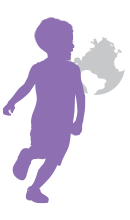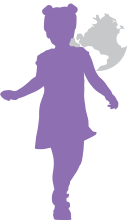Component 3: History
Standard 3.a: Children develop an understanding of the passage of time as it relates to historical changes in events, people, and the world.
By the following age ranges, children typically, for example:
- Show anticipation for routine activities

- Imitate simple actions observed in the recent past (e.g., walk a stuffed animal dog; feed a baby doll)

- Follow routines with simple sequences of events practiced in the past with adult assistance (e.g., put backpack in cubby when they arrive; wash hands after breakfast)
- Begin to understand the passage of time and the meaning of phrases like “after lunch”

- Demonstrate an awareness of a daily routine (e.g., say “We go outside after we have snack”; get blanket when ready for naptime)
- Begin to connect past and present experiences (e.g., discuss how they can do a skill because they are a big kid now).
- Recognize familiar people even though there may be slight differences in their appearance (e.g., new haircut, taller)

- Communicate routine events or activities that happened earlier in time using basic vocabulary but not always accurately, (e.g., today, tomorrow, or yesterday)
- Recall information about the immediate past (e.g., tell parents during pick-up what they did at school today; explain how they saw a squirrel on their walk)
- Distinguish older family from younger ones and recent past events from events that happened long ago (e.g., communicate that “Grandpa is coming soon, I haven’t seen him for a long time— since I was a baby)”
- Explore changes that take place over time in the immediate environment (e.g., match pictures of baby animals with adult animals; observe growth of plants in gardens)

- Understand and accurately communicate daily routines and sequences of events and experiences in the context of time, using appropriate vocabulary (e.g., retells: “Yesterday I went home after lunch but today I’m going home after rest.”)
- Show improving ability to differentiate and discuss past, present, and future events (e.g., recount a family story, share where they will go on vacation)
- Develop an interest in family history and historical events (e.g., discuss when family members were children)
- Observe and recognize that everything (people, events, the world) changes over time (e.g., recount the life cycle of a plant or butterfly)

Standard 3.b: Children gain awareness of themselves and others as members of diverse families, communities, and cultures.
By the following age ranges, children typically, for example:
- Begin to explore characteristics of themselves (e.g., observe themselves in a mirror, look at their own hands and feet)
- Demonstrate a preference for familiar versus unfamiliar adults (e.g., smile, kick legs, or reach when seeing a familiar person)

- Show awareness of the unique attributes of people (e.g., reach out to touch another’s hair or face)
- Use simple words to show recognition of family members (e.g., mama for mom)
- Demonstrate curiosity about similarities and differences between people (e.g., looking longer at a person of a different race, noticing a change in someone’s appearance)

- Refer to themselves by name
- Explore characteristics of others
- Identify immediate family members (e.g., recognize known people in pictures; respond to familiar family members and other adults)
- Shadow adults in their work by imitating such activities as sweeping or picking up toys, and attempting to help

- Identify own traits and characteristics
- Express curiosity about similarities and differences among people, families, and communities
- Identify immediate family members and some extended family (e.g., create a representation of their family and identify their mommy and brother)
- Engage in pretend play and act out different settings or events that happen at home (e.g., be a doll’s daddy and use spoon to feed the doll)
- With adult support, begin to share about community events or family activities they participated in (e.g., when asked, say “my family went to the beach” or explain how they went apple-picking last weekend)

- Recognize similarities and differences between themselves and others (e.g., say “Your hair is short, my hair is long”)
- Demonstrate an understanding of self as part of a family (e.g., communicate that they are a sister or daughter)
- Engage in pretend play using objects as
representations of something else (e.g., use a block as a phone or small rocks as dog food) - Identify cultural characteristics and/or traditions of self, family, and community (e.g., retell that “when there is no school, Tia makes pancakes for breakfast” or “we went to the parade”)

- Use comparative language to describe similarities and differences among people and use themselves as a reference (e.g., say “That boy is bigger than me”)
- Engage in pretend play with other children that is planned and organized around a specific theme or task, often with assigned roles (e.g., play house and determine who is going to be the mommy and the baby; plan a veterinary clinic and the stuffed animals that they will care for)
- Identify and express curiosity about similarities and differences among the physical and cultural characteristics of people, families, and communities (e.g., after looking at her classmate’s self-portrait, say,
“Why is everybody’s hair different?” Or “My family speaks Spanish at home.”)

